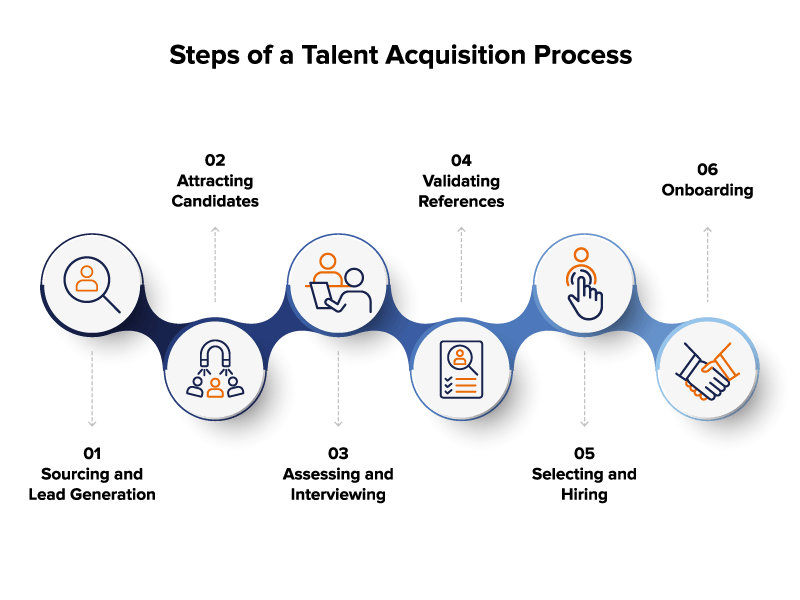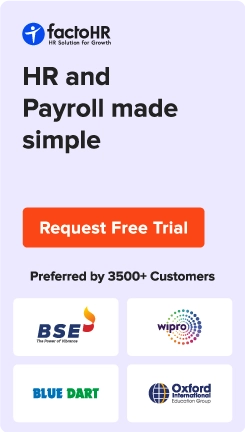Talent Acquisition
Table of Contents
What is Talent Acquisition?
Talent acquisition is a systematic method of determining, attracting, screening, and hiring talented employees having the right skills for the right positions as per the company’s present and future requirements. This process is generally controlled by a team in the human resource department or a separate talent acquisition (TA) department.
The essential point is that this procedure is equal for all the workforce types, such as full-time, part-time, contingent, contract-based, and outsourcing.

Steps of a Talent Acquisition Process
The talent acquisition process can be divided into various steps, which are equally essential for all companies.

Sourcing and Lead Generation
To begin with, identify social platforms, communities, events, seminars, etc., where you can interact, develop relationships, and specify your talent requirement. This gives you access to a larger applicant pool, which can help you discover the best talents according to your needs.
Attracting Candidates
Today’s workforce mainly involves Millennials, the generation who looks beyond CTC and salary packages. So, to attract them, it is essential to highlight your company’s unique qualities such as branding, culture, compensation, benefits, core values, wellness programs, etc.
Assessing and Interviewing
Understand which tasks are essential for a particular job position. This helps you in formulating interview questions that actually evaluate the capabilities and bring out the right skills of the candidate. Besides technical tests, you can also implement personality tests, aptitude tests, etc., which help you understand the candidate’s interpersonal and team-building skills.
Validating References
Assessing the candidates isn’t enough to understand if they are the right fit for your company. Check various references about the applicant to check if you’ve overlooked any qualities, character, or impressions that are important in the workplace. You can confirm your decision to hire the candidate if your assessments and references match.
Selecting and Hiring
During the final selection, the respective manager will choose the candidates who deserve the position the most among all. This can be accomplished by evaluating exceptional skills, the necessary experience to take the company to the next level, and the capability to lead the team.
Onboarding
This step involves familiarizing the employee with the company's culture, behavior, and workflows. It also involves collecting and storing employee information, letter generation, and asset assignment. Due to technological advancement, employee onboarding software can also simplify this step and make onboarding smooth and streamlined for new hires. An essential point to note is that this step can decide if the employee will stay in the long run.

Trending Terms That People Also Look Up
Frequently Asked Questions
How does talent acquisition differ from recruitment?
Both the terms carry the same meaning but differ on the basis of their purpose and approach.
Recruitment is more of an operational task used by companies only to fill out vacant positions and to satisfy short-term requirements. On the contrary, talent acquisition is a strategic and broader approach as compared to recruitment and is used to fulfill long-term needs. It is, in fact, a continuous process of evaluating candidates for positions of leader, executive, and specialist.
What are the tips for successful talent acquisition?
Talent acquisition is an essential part of workforce planning and growth. Here are some crucial tips to make the process profitable.
- Align the process with your business targets.
- Develop company branding.
- Promote corporate social responsibility.
- Improve diversity, equity, and inclusion.
- Ensure a compliant and beneficial compensation plan.
- Expand your outreach methods.
- Provide trending work options.
What is the importance of talent acquisition?
For any company, its employees are the biggest growth drivers, and talent acquisition thus becomes the essential process. Specialists in this field do not just hire to close down the position but also look after the candidate's overall growth because it is indirectly proportional to business growth.
Moreover, with the carefulness of TA experts in seeking candidates having the right set of skills needed for the future requirements, they aim to reduce the turnover rate and bad hires to save hiring costs. They also look for aspects such as leadership, team bonding, behavior, innovativeness, etc., in the candidates because they can take the company to the next level of productivity.
Modify your HR and payroll tasks with factoHR today
Let your HR and workforce focus on most important business decisions while factoHR can reduce the burden of daily activities of the organization.

© 2025 Copyright factoHR

